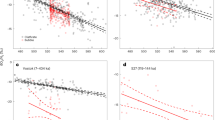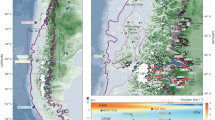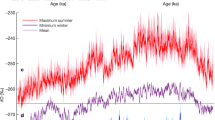Abstract
FOR more than one hundred years many different authors have claimed a causal relationship between the astronomical motions of the Earth and the alternating glacial and interglacial ages of the Pleistocene epoch. Köppen and Wegener1, using the insolation curves calculated by Milankovitch, concluded that glaciation was controlled by summer insolation variations at the high northern latitudes. This theory was brought up to date and amplified by Emiliani and Geiss2. Wilson3 suggested that summer insolation variations at the high southern latitudes controlled glaciation, making Antarctic ice surges and retreats the principal controlling agents for world climate. There is an average lag of 10,000 yr between the northern and the southern curves, with the latter leading. The purpose of this work is to determine the lag between the summer insolation curve at lat. 65° N and the temperature maxima and minima of core P-6304–9, as measured by the oxygen isotopic method. The method of visual correlation is difficult because noise coming from various mechanisms is superimposed on the core data. In an article by Kemp et al.4 core P-6304–9 was compared with the summer insolation at 65° N lat. by the method of power spectral analysis. The estimators from the auto-correlation functions in this case were those of Evans et al.5. Now these estimators are valid only for auto-correlation functions and not for cross-correlation, so the classical method is used in this communication. The auto and cross-correlation functions are expanded in the orthonormal set of Laguerre functions. The advantage is that all have rigorous Fourier transforms and thus the resulting spectra will be continuous functions of the frequency. This is not the case when the above integrals are evaluated numerically (the usual procedure) because the wavelengths chosen must be commensurate with the total record length. This method was checked by simulation such that the frequencies and relative phases involved were known in advance. One hundred and fifty correlation coefficients were calculated and the data were interpolated 2 for 1 which resulted in 289 data points. Only that part of the spectra is used which leaves the coherency matrix hermitian. The expansion in Laguerre functions and their transforms was carried to the thirtieth order.
This is a preview of subscription content, access via your institution
Access options
Subscribe to this journal
Receive 51 print issues and online access
$199.00 per year
only $3.90 per issue
Buy this article
- Purchase on Springer Link
- Instant access to full article PDF
Prices may be subject to local taxes which are calculated during checkout
Similar content being viewed by others
References
Köppen, W., and Wegener, A., Die Klimate der Geologischen Vorzeit., Berlin, 256 (1924).
Emiliani, C., and Geiss, J., Geol. Rundschau, 46, 576 (1959).
Wilson, A. T., Nature, 201, 147 (1964).
Kemp, Warren C., and Eger, Donald T., J. Geophys Res., 72, 739 (1967).
Evans, G. W., II, Sutherland, G. L., McCarty, R. C., and Omlor, P. H., Stanford Res. Inst. Rep., No. 419493 (1965).
Author information
Authors and Affiliations
Rights and permissions
About this article
Cite this article
KEMP, W. Evidence for Pleistocene Ice Lags. Nature 221, 1231–1232 (1969). https://doi.org/10.1038/2211231a0
Received:
Published:
Issue Date:
DOI: https://doi.org/10.1038/2211231a0
Comments
By submitting a comment you agree to abide by our Terms and Community Guidelines. If you find something abusive or that does not comply with our terms or guidelines please flag it as inappropriate.



